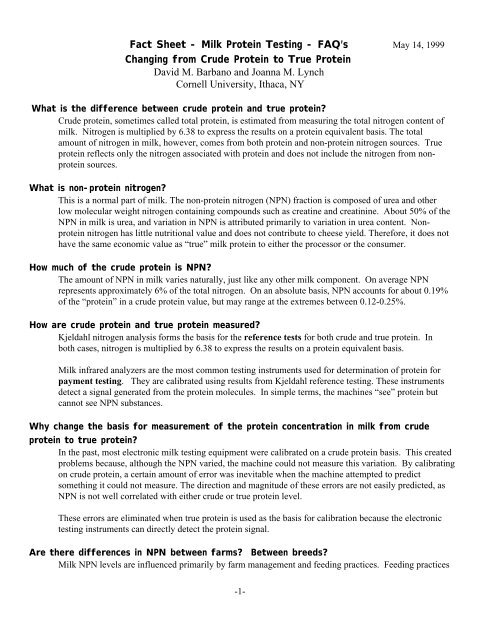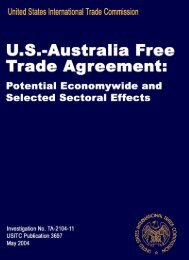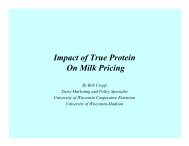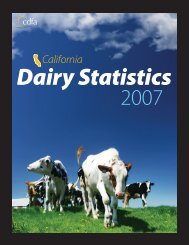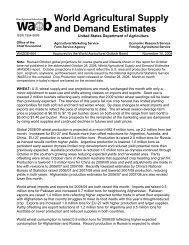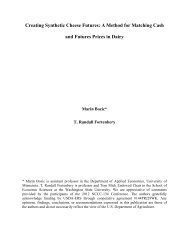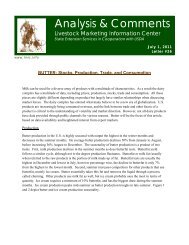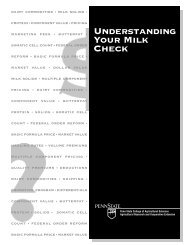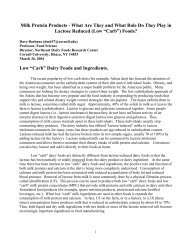Fact Sheet - Milk Protein Testing - Changing from Crude Protein to ...
Fact Sheet - Milk Protein Testing - Changing from Crude Protein to ...
Fact Sheet - Milk Protein Testing - Changing from Crude Protein to ...
Create successful ePaper yourself
Turn your PDF publications into a flip-book with our unique Google optimized e-Paper software.
<strong>Fact</strong> <strong>Sheet</strong> - <strong>Milk</strong> <strong>Protein</strong> <strong>Testing</strong> - FAQ’s May 14, 1999<br />
<strong>Changing</strong> <strong>from</strong> <strong>Crude</strong> <strong>Protein</strong> <strong>to</strong> True <strong>Protein</strong><br />
David M. Barbano and Joanna M. Lynch<br />
Cornell University, Ithaca, NY<br />
What is the difference between crude protein and true protein?<br />
<strong>Crude</strong> protein, sometimes called <strong>to</strong>tal protein, is estimated <strong>from</strong> measuring the <strong>to</strong>tal nitrogen content of<br />
milk. Nitrogen is multiplied by 6.38 <strong>to</strong> express the results on a protein equivalent basis. The <strong>to</strong>tal<br />
amount of nitrogen in milk, however, comes <strong>from</strong> both protein and non-protein nitrogen sources. True<br />
protein reflects only the nitrogen associated with protein and does not include the nitrogen <strong>from</strong> nonprotein<br />
sources.<br />
What is non-protein nitrogen?<br />
This is a normal part of milk. The non-protein nitrogen (NPN) fraction is composed of urea and other<br />
low molecular weight nitrogen containing compounds such as creatine and creatinine. About 50% of the<br />
NPN in milk is urea, and variation in NPN is attributed primarily <strong>to</strong> variation in urea content. Nonprotein<br />
nitrogen has little nutritional value and does not contribute <strong>to</strong> cheese yield. Therefore, it does not<br />
have the same economic value as “true” milk protein <strong>to</strong> either the processor or the consumer.<br />
How much of the crude protein is NPN?<br />
The amount of NPN in milk varies naturally, just like any other milk component. On average NPN<br />
represents approximately 6% of the <strong>to</strong>tal nitrogen. On an absolute basis, NPN accounts for about 0.19%<br />
of the “protein” in a crude protein value, but may range at the extremes between 0.12-0.25%.<br />
How are crude protein and true protein measured?<br />
Kjeldahl nitrogen analysis forms the basis for the reference tests for both crude and true protein. In<br />
both cases, nitrogen is multiplied by 6.38 <strong>to</strong> express the results on a protein equivalent basis.<br />
<strong>Milk</strong> infrared analyzers are the most common testing instruments used for determination of protein for<br />
payment testing. They are calibrated using results <strong>from</strong> Kjeldahl reference testing. These instruments<br />
detect a signal generated <strong>from</strong> the protein molecules. In simple terms, the machines “see” protein but<br />
cannot see NPN substances.<br />
Why change the basis for measurement of the protein concentration in milk <strong>from</strong> crude<br />
protein <strong>to</strong> true protein?<br />
In the past, most electronic milk testing equipment were calibrated on a crude protein basis. This created<br />
problems because, although the NPN varied, the machine could not measure this variation. By calibrating<br />
on crude protein, a certain amount of error was inevitable when the machine attempted <strong>to</strong> predict<br />
something it could not measure. The direction and magnitude of these errors are not easily predicted, as<br />
NPN is not well correlated with either crude or true protein level.<br />
These errors are eliminated when true protein is used as the basis for calibration because the electronic<br />
testing instruments can directly detect the protein signal.<br />
Are there differences in NPN between farms? Between breeds?<br />
<strong>Milk</strong> NPN levels are influenced primarily by farm management and feeding practices. Feeding practices<br />
-1-
account for much of the variation in NPN observed between farms, regions and seasons. Any differences<br />
in NPN between breeds will be small compared <strong>to</strong> the effects of diet.<br />
Will expressing protein as true protein rather than crude protein decrease my protein<br />
test?<br />
On an absolute basis, yes.<br />
Will the lower protein test decrease the milk price?<br />
No. The value of protein will be increased <strong>to</strong> compensate for the decrease in protein. The change in test<br />
level in the Federal <strong>Milk</strong> Markets will be revenue neutral.<br />
How do I compare my true protein tests <strong>to</strong> my previous crude protein records?<br />
Add 0.19% <strong>to</strong> the true protein values <strong>to</strong> get an approximate estimate of crude protein.<br />
You say that NPN levels can vary. So is adding a constant correction of 0.19% <strong>to</strong> estimate<br />
crude protein <strong>from</strong> true protein accurate?<br />
Estimates of crude protein based on electronic milk testing have never been accurate with respect <strong>to</strong> the<br />
actual amount of NPN in milk, since this is not a component that the machine can measure. Adding a<br />
constant fac<strong>to</strong>r contributes no greater error than previously occurred when instruments were calibrated<br />
on a crude protein basis.<br />
How will changing <strong>from</strong> crude protein <strong>to</strong> true protein influence genetic selection for protein<br />
production?<br />
Using true protein will reduce the amount of random error in milk protein production data and improve<br />
the data quality for genetic selection. This will be an advantage for genetic selection for improved<br />
protein production in all breeds within the US. The actual value of protein production can be adjusted <strong>to</strong><br />
a crude protein basis by adding 0.19% <strong>to</strong> the true protein test <strong>to</strong> make data comparable <strong>to</strong> his<strong>to</strong>ric data<br />
and data <strong>from</strong> other countries that still express milk protein on a crude protein basis.<br />
Will this change in payment testing affect nutritional labeling?<br />
No. <strong>Crude</strong> protein is the basis for nutritional labeling on an international basis.<br />
Do any other countries express milk protein content for payment testing on a true protein<br />
basis?<br />
Yes. France and Australia.<br />
Please summarize the advantages of using true protein instead of crude protein.<br />
Using true protein instead of crude protein will better reflect the economic value of milk protein.<br />
Additionally, it will improve the accuracy of payment testing for protein by eliminating sources of<br />
random error. This will result in more equitable and accurate protein tests, and improve the quality of<br />
data used for genetic selection and farm management.<br />
-2-


